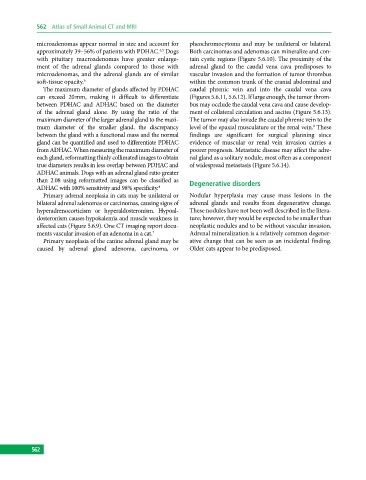Page 572 - Atlas of Small Animal CT and MRI
P. 572
562 Atlas of Small Animal CT and MRI
microadenomas appear normal in size and account for pheochromocytoma and may be unilateral or bilateral.
approximately 39–56% of patients with PDHAC. Dogs Both carcinomas and adenomas can mineralize and con-
4,5
with pituitary macroadenomas have greater enlarge- tain cystic regions (Figure 5.6.10). The proximity of the
ment of the adrenal glands compared to those with adrenal gland to the caudal vena cava predisposes to
microadenomas, and the adrenal glands are of similar vascular invasion and the formation of tumor thrombus
soft‐tissue opacity. 6 within the common trunk of the cranial abdominal and
The maximum diameter of glands affected by PDHAC caudal phrenic vein and into the caudal vena cava
can exceed 20 mm, making it difficult to differentiate (Figures 5.6.11, 5.6.12). If large enough, the tumor throm-
between PDHAC and ADHAC based on the diameter bus may occlude the caudal vena cava and cause develop-
of the adrenal gland alone. By using the ratio of the ment of collateral circulation and ascites (Figure 5.6.13).
maximum diameter of the larger adrenal gland to the maxi- The tumor may also invade the caudal phrenic vein to the
mum diameter of the smaller gland, the discrepancy level of the epaxial musculature or the renal vein. These
8
between the gland with a functional mass and the normal findings are significant for surgical planning since
gland can be quantified and used to differentiate PDHAC evidence of muscular or renal vein invasion carries a
from ADHAC. When measuring the maximum diameter of poorer prognosis. Metastatic disease may affect the adre-
each gland, reformatting thinly collimated images to obtain nal gland as a solitary nodule, most often as a component
true diameters results in less overlap between PDHAC and of widespread metastasis (Figure 5.6.14).
ADHAC animals. Dogs with an adrenal gland ratio greater
than 2.08 using reformatted images can be classified as Degenerative disorders
ADHAC with 100% sensitivity and 98% specificity. 4
Primary adrenal neoplasia in cats may be unilateral or Nodular hyperplasia may cause mass lesions in the
bilateral adrenal adenomas or carcinomas, causing signs of adrenal glands and results from degenerative change.
hyperadrenocorticism or hyperaldosteronism. Hypoal- These nodules have not been well described in the litera-
dosteronism causes hypokalemia and muscle weakness in ture; however, they would be expected to be smaller than
affected cats (Figure 5.6.9). One CT imaging report docu- neoplastic nodules and to be without vascular invasion.
ments vascular invasion of an adenoma in a cat. 7 Adrenal mineralization is a relatively common degener-
Primary neoplasia of the canine adrenal gland may be ative change that can be seen as an incidental finding.
caused by adrenal gland adenoma, carcinoma, or Older cats appear to be predisposed.
562

